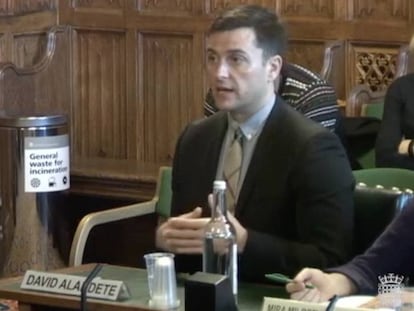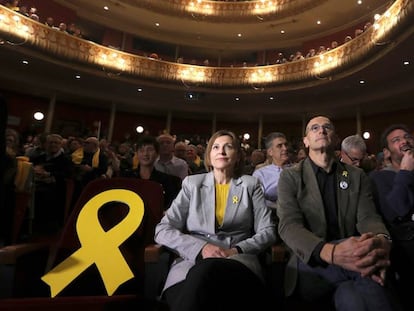Down to the wire: our final prediction of Catalan election results
EL PAÍS used sophisticated statistical model to forecast vote and seat distribution after December 21

With just two days to go before the Catalan regional elections, El PAIS has made a final forecast of the outcome that suggest a tight race between pro-independence parties and so-called constitutionalist parties, which are against independence.
The tightly contested election was called by Spanish Prime Minister Mariano Rajoy using emergency powers under Article 155 of the Spanish Constitution – a move that came in response to the passing of a unilateral declaration of independence in the regional parliament on October 27.
According to the EL PAÍS model, constitutional party Ciudadanos and pro-independence party Republican Left of Catalonia (ERC) are set to tie, with Ciudadanos predicted to win the highest percentage of votes and ERC the largest number of seats. There are 135 seats in the Catalan parliament, meaning a party or bloc must win at least 68 to hold the majority.
The model used by EL PAÍS combines the results from dozens of polls (published before Saturday, December 16) and thousands of simulations to calibrate the prediction with greater precision.
It would be difficult for the three constitutionalist parties to form a majority without extra support
Poll results have fluctuated in the past days, and last week they showed Ciudadanos in the lead. Ciudadanos gets around 23.3% of the vote, followed by ERC with 22.2%. Pro-independence party Junts per Catalunya (JxCat), led by ousted Catalan premier Carles Puigdemont, is in third place with 17.7% of the vote, followed by the anti-independence Socialist party (PSC) with 15.3% of the vote.
The Catalunya en Comú–Podem coalition (CeC-Podem), formed by the party of Barcelona mayor Ada Colau and the Catalan branch of Spain’s anti-austerity party Podemos, is predicted to win 8% of the vote. The CeC-Podem is opposed to both the application of Article 155 and any universal declaration of independence in the region.
According to the model, the radical anti-austerity party CUP, which supports independence, will win 6.2% of the vote, followed by the conservative Popular Party (PP) with 5.5% of the vote.
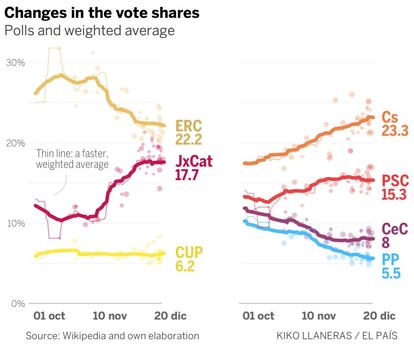
Prediction of seat allocation
By averaging out the results, the EL PAÍS model has calculated the number of seats each party is likely to win. To do this, the vote was simulated 10,000 times in each Catalan province: Barcelona, Tarragona, Lleida and Girona. The graph below outlines how many seats will be won by each party. According to the model, ERC will secure around 33 seats, followed by Ciudadanos with 31-32 seats, JxCat (27), PSC (20), CeC-Podem (9), CUP (8) and the PP (6).
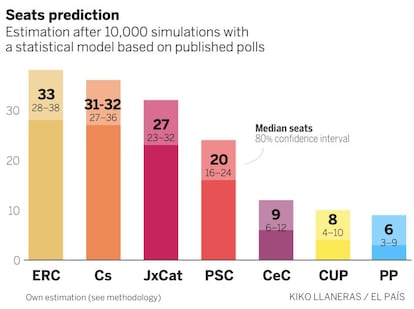
Is a majority possible?
The driving question is which parties will win enough seats to govern and choose the next premier of Catalonia. What is the likelihood of different groups of parties winning the 68 seats needed to form a majority government? The following forecast cannot be offered by conventional polls but can be calculated with our electoral model.
The following graph represents the number of seats each group of parties could achieve, based on 10,000 simulations of the regional vote. The block to the right represents the likelihood of different groups of parties winning a majority of seats.
According to the results, the pro-independence parties (ERC, JxCat and CUP) have a 54% chance of winning the highest number of seats. But it is only just over a 50-50 chance, no more than a coin toss. In the remaining 46% of the simulations, Ciudadanos, PSC, PP and CeC-Podem together would have 68 seats and could theoretically form an agreement.
According to the model, it would be difficult for the three constitutionalist parties to form a majority without extra support from CeC-Podem. Ciudadanos, PSC and PP together are only tipped to win 58 seats. It is not impossible for the group to win the 68 seats needed for a majority government, but it is an outcome that only occurred three times in every 100 simulations.

Nor is there certainty about the number of seats that the combination of ERC, Cec-Podem and PSC could win. This kind of agreement would be politically complex and according to the model, these three parties only reached 68 seats in 14% of the simulations.
Another outcome is for ERC to govern with the support of JxCat and Cec-Podem. Together these three parties have 68 seats in 70% of the simulations. But the probability of this result falls to 48% if the pro-independence bloc (ERC, JxCat and CUP) do not reach a majority.
The fight for first place
In terms of the probability of each party coming in first place in votes, it’s clear there is still much uncertainty. In our model, Ciudadanos received the most votes in 55% of the simulations and ERC in 40%.
The ERC is the party most likely to win the highest number of seats, followed by Ciudadanos which comes out in top position in 34% of the simulations, and JxCat in 8%. The difference between the votes and seats is related to how the electoral system allocates seats. Seats for the provinces of Tarragona, Lleida and Girona can be earned with fewer votes than seats for Barcelona province. And pro-independence parties are stronger in those three provinces, which explains why pro-independence parties could win more seats but fewer votes.
It is important to carefully interpret the probabilities and not exaggerate the differences. The gap between ERC (which wins 58% of the time) and Ciudadanos (which wins in 34% of the simulations) may appear very wide, but the race is extremely tight. Think of a die. Ciudadanos wins if it lands on 1 or 2, ERC wins if it lands on 3,4 or 5 and if it falls on 6, either ERC or JxCat win (heads or tails).
Seats according to each province
The last graph shows the seats up for grabs, safe seats and those that are likely to be safe in each province. Tactical voting, where voters support a candidate who is not their preferred choice to prevent an unfavorable outcome, is not as frequent in regional elections as it is in general elections. But the model does suggest strategies for those who trust its predictions.
For example, a voter in Girona who is deciding between ERC and CUP has more options of winning a seat voting for the former. In Tarragona, there are seats belonging to PSC and Ciudadanos that are up for grabs, but none from PP or Cec-Podem. And in Lleida, if a voter is deciding between the three pro-independence parties, they should rule out ERC because they have fewer seats at risk.
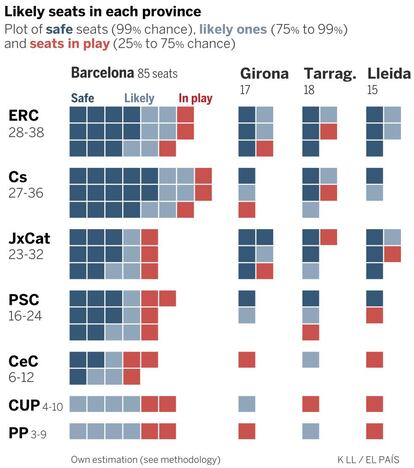
English version by Melissa Kitson.
Tu suscripción se está usando en otro dispositivo
¿Quieres añadir otro usuario a tu suscripción?
Si continúas leyendo en este dispositivo, no se podrá leer en el otro.
FlechaTu suscripción se está usando en otro dispositivo y solo puedes acceder a EL PAÍS desde un dispositivo a la vez.
Si quieres compartir tu cuenta, cambia tu suscripción a la modalidad Premium, así podrás añadir otro usuario. Cada uno accederá con su propia cuenta de email, lo que os permitirá personalizar vuestra experiencia en EL PAÍS.
¿Tienes una suscripción de empresa? Accede aquí para contratar más cuentas.
En el caso de no saber quién está usando tu cuenta, te recomendamos cambiar tu contraseña aquí.
Si decides continuar compartiendo tu cuenta, este mensaje se mostrará en tu dispositivo y en el de la otra persona que está usando tu cuenta de forma indefinida, afectando a tu experiencia de lectura. Puedes consultar aquí los términos y condiciones de la suscripción digital.
More information
Archived In
Últimas noticias
Reinhard Genzel, Nobel laureate in physics: ‘One-minute videos will never give you the truth’
Pinochet’s victims grapple with José Antonio Kast’s rise in Chile
How Japan is trying to avert ‘digital defeat’
The complicated life of Francesca Albanese: A rising figure in Italy but barred from every bank by Trump’s sanctions
Most viewed
- Pablo Escobar’s hippos: A serious environmental problem, 40 years on
- Why we lost the habit of sleeping in two segments and how that changed our sense of time
- Charles Dubouloz, mountaineering star, retires at 36 with a farewell tour inspired by Walter Bonatti
- Trump’s obsession with putting his name on everything is unprecedented in the United States
- The Florida Keys tourist paradise is besieged by immigration agents: ‘We’ve never seen anything like this’

